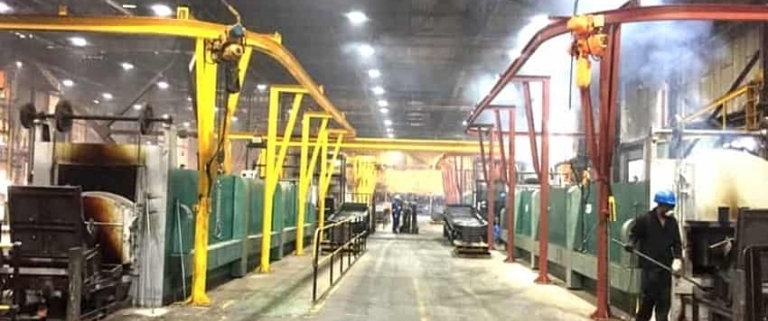How do continuous heat treatment furnaces affect the performance of grinding media balls?
In modern industrial production, grinding media balls are widely used in grinding operations in industries such as ores, chemicals, and building materials. Their performance directly impacts production efficiency and product quality. As a highly efficient metal heat treatment equipment, continuous heat treatment furnaces play a vital role in improving the performance of grinding media balls through precise temperature control and a continuous process flow. This article will explore how continuous heat treatment furnaces affect the hardness, wear resistance, and toughness of grinding media balls, providing a theoretical basis for improving their service life and grinding efficiency.
Definition of a Continuous Heat Treatment Furnace
A continuous heat treatment furnace is a type of equipment commonly used in the heat treatment of metal materials. It primarily heats, holds, and cools metal parts to modify their physical and chemical properties and achieve the desired performance. Unlike traditional batch heat treatment furnaces, continuous heat treatment furnaces use a continuous process flow to rapidly and uniformly treat metal workpieces, enabling efficient production and reducing operator input. Consisting primarily of heating, holding, and cooling zones, they offer advantages such as high temperature control precision, rapid processing speed, and high production efficiency.
In industrial applications, continuous heat treatment furnaces are widely used to treat materials such as steel and aluminum alloys. They are particularly well-suited for large-scale production applications requiring heat treatment of large numbers of parts or materials.
The Specific Functions of Continuous Heat Treatment Furnaces
Continuous heat treatment furnaces play a vital role in metal processing. First, through heating and cooling, the heat treatment process can alter the metal’s microstructure, thereby improving its mechanical properties, such as hardness, wear resistance, and tensile strength. For certain metals, continuous heat treatment furnaces can also optimize properties such as ductility and toughness by adjusting temperature and time parameters.
Specifically, the main functions of continuous heat treatment furnaces include:
Improving Hardness and Wear Resistance: Through appropriate heating and cooling methods, a harder martensitic structure can be formed on the metal surface, enhancing the material’s hardness and wear resistance.
Improving Plasticity and Toughness: By controlling the heating and cooling rates, heat treatment furnaces can adjust the metal’s microstructure, thereby optimizing the material’s plasticity and toughness, thereby preventing cracks or brittle fractures in practical applications. Stress and Defect Removal: During the continuous heat treatment process, residual stress within the metal can be effectively released, while also repairing some defects introduced during the casting or molding process.
How Continuous Heat Treatment Furnaces Affect the Performance of Grinding Media Balls
Grinding media balls are widely used in grinding operations in the ore, chemical, and building materials industries and are a critical component of grinding equipment. The performance of the grinding media balls directly impacts the efficiency of the grinding process and the quality of the product. Continuous heat treatment furnaces play a crucial role in the production of grinding media balls.
Hardness Improvement: Continuous heat treatment furnaces can significantly improve the hardness of grinding media balls by precisely controlling the heating and cooling processes. During the heat treatment process, the internal structure of the metal balls changes, enhancing their wear resistance. This process is crucial for improving grinding efficiency and extending the life of the balls.
Uniformity and Stability: Through the efficient treatment of the continuous heat treatment furnace, the material of the grinding media balls is uniformly heated and cooled, ensuring consistent physical properties for each ball and avoiding performance fluctuations or inhomogeneities that can occur during mass production. This uniformity not only improves the stability of the grinding process but also reduces the loss of grinding efficiency caused by variations in ball performance.
Impact resistance: Grinding media balls operate in environments with high impact and friction, making their impact resistance crucial. Through proper temperature control, continuous heat treatment furnaces can adjust the internal structure of the media balls, improving their toughness and impact resistance. This prevents breakage over long-term use, reducing replacement frequency and production costs.
Corrosion resistance: Certain grinding media balls, such as stainless steel and alloy steel balls, are designed to operate in corrosive environments. The heat treatment process during continuous heat treatment improves the corrosion resistance of the grinding media balls by forming a more stable metal phase, thereby extending their service life.
Fatigue resistance: During long-term grinding, media balls are often subjected to repeated stresses, which can lead to fatigue failure. Continuous heat treatment optimizes the internal structure of the metal, enhancing its fatigue resistance and effectively reducing failures caused by fatigue cracking.
Through precise control of the heating, holding, and cooling processes, continuous heat treatment furnaces can effectively improve the hardness, wear resistance, toughness, and corrosion resistance of grinding media balls. These changes not only improve grinding efficiency but also extend the service life of the media balls, reducing maintenance and replacement costs. With the continuous development of continuous heat treatment technology, its application prospects in the production of grinding media balls are becoming increasingly broad, and it will provide more reliable solutions for various industrial production.

